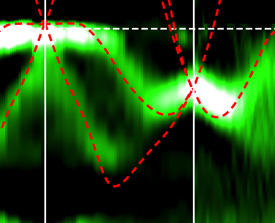

05/27/2019

Reprinted, with permission, from Ref. 1 © 2019 by the American Physical Society
Two new fermions have been found in a topological material by AIMR researchers1. This is remarkable because, unlike ‘quasiparticle’ fermions previously discovered in material systems, these two quasiparticle fermions lack particle counterparts that can exist in a vacuum.
Particles with an integer spin are classified as bosons, whereas particles with a half-integer spin are called fermions. The best known example of a fermion is the electron, which has a spin of one half.
According to quantum field theory, fermions in a vacuum can be further classified into three types: Dirac, Weyl or Majorana fermions. Of these, only Dirac fermions have been observed as particles in high-energy physics experiments performed at massive particle accelerators such as CERN’s Large Hadron Collider. But Dirac and Weyl fermions also been found as quasiparticles — collective excitations of electrons that behave as particles — in topological materials, exotic systems whose surface properties differ greatly from their bulk properties.
Now, Takafumi Sato of the AIMR at Tohoku University and his co-workers have found two new fermion quasiparticles that do not fit into any of the three categories. They discovered these fermions in cobalt silicide (CoSi) by using synchrotron radiation to probe the energy levels of electrons in the material.
“Our discovery is exciting because it adds a new category of fermionic quasiparticles to the well-known Dirac and Weyl fermions,” explains Sato. “We anticipate it will stimulate the search for new types of fermionic quasiparticles in a wider variety of topological materials using synchrotron radiation.”
The researchers were inspired to search for the fermions by a theoretical prediction published two years ago that materials such as cobalt silicide with a chiral crystal structure will harbor such fermions. The specific point-group symmetry of these crystals permits them to host fermions that cannot exist in the higher symmetry of free space.
Sato notes that it was challenging to prepare samples of CoSi that were clean and flat enough to analyze. “We cleaved millimeter-sized bulk CoSi crystals more than 50 times,” he recalls. “In just a few cases, we were able to obtain a sufficiently flat surface in a very narrow region of about 100 by 100 micrometers.”
The discovery could lead to practical applications in the future. “While it’s still early days, this finding could pave the way toward realizing next-generation electronic devices that utilize new fermions,” notes Sato. “They may be useful for high-speed devices because nodal fermions generally have high mobilities, and their chirality might make them applicable to some opto- and magneto-electronic devices.”
This research highlight has been approved by the authors of the original article and all information and data contained within has been provided by said authors.